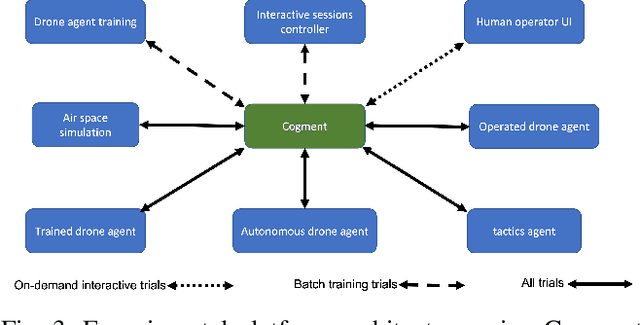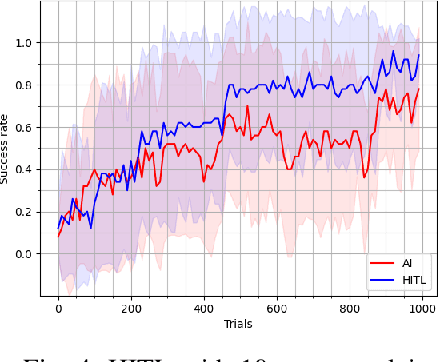Matthew Guzdial
A Systematic Approach to Design Real-World Human-in-the-Loop Deep Reinforcement Learning: Salient Features, Challenges and Trade-offs
Apr 23, 2025



Abstract:With the growing popularity of deep reinforcement learning (DRL), human-in-the-loop (HITL) approach has the potential to revolutionize the way we approach decision-making problems and create new opportunities for human-AI collaboration. In this article, we introduce a novel multi-layered hierarchical HITL DRL algorithm that comprises three types of learning: self learning, imitation learning and transfer learning. In addition, we consider three forms of human inputs: reward, action and demonstration. Furthermore, we discuss main challenges, trade-offs and advantages of HITL in solving complex problems and how human information can be integrated in the AI solution systematically. To verify our technical results, we present a real-world unmanned aerial vehicles (UAV) problem wherein a number of enemy drones attack a restricted area. The objective is to design a scalable HITL DRL algorithm for ally drones to neutralize the enemy drones before they reach the area. To this end, we first implement our solution using an award-winning open-source HITL software called Cogment. We then demonstrate several interesting results such as (a) HITL leads to faster training and higher performance, (b) advice acts as a guiding direction for gradient methods and lowers variance, and (c) the amount of advice should neither be too large nor too small to avoid over-training and under-training. Finally, we illustrate the role of human-AI cooperation in solving two real-world complex scenarios, i.e., overloaded and decoy attacks.
Personalizing Exposure Therapy via Reinforcement Learning
Apr 18, 2025Abstract:Personalized therapy, in which a therapeutic practice is adapted to an individual patient, can lead to improved health outcomes. Typically, this is accomplished by relying on a therapist's training and intuition along with feedback from a patient. However, this requires the therapist to become an expert on any technological components, such as in the case of Virtual Reality Exposure Therapy (VRET). While there exist approaches to automatically adapt therapeutic content to a patient, they generally rely on hand-authored, pre-defined rules, which may not generalize to all individuals. In this paper, we propose an approach to automatically adapt therapeutic content to patients based on physiological measures. We implement our approach in the context of virtual reality arachnophobia exposure therapy, and rely on experience-driven procedural content generation via reinforcement learning (EDPCGRL) to generate virtual spiders to match an individual patient. Through a human subject study, we demonstrate that our system significantly outperforms a more common rules-based method, highlighting its potential for enhancing personalized therapeutic interventions.
Label-Free Subjective Player Experience Modelling via Let's Play Videos
Oct 03, 2024



Abstract:Player Experience Modelling (PEM) is the study of AI techniques applied to modelling a player's experience within a video game. PEM development can be labour-intensive, requiring expert hand-authoring or specialized data collection. In this work, we propose a novel PEM development approach, approximating player experience from gameplay video. We evaluate this approach predicting affect in the game Angry Birds via a human subject study. We validate that our PEM can strongly correlate with self-reported and sensor measures of affect, demonstrating the potential of this approach.
Mechanic Maker: Accessible Game Development Via Symbolic Learning Program Synthesis
Oct 01, 2024



Abstract:Game development is a highly technical practice that traditionally requires programming skills. This serves as a barrier to entry for would-be developers or those hoping to use games as part of their creative expression. While there have been prior game development tools focused on accessibility, they generally still require programming, or have major limitations in terms of the kinds of games they can make. In this paper we introduce Mechanic Maker, a tool for creating a wide-range of game mechanics without programming. It instead relies on a backend symbolic learning system to synthesize game mechanics from examples. We conducted a user study to evaluate the benefits of the tool for participants with a variety of programming and game development experience. Our results demonstrated that participants' ability to use the tool was unrelated to programming ability. We conclude that tools like ours could help democratize game development, making the practice accessible regardless of programming skills.
Spiders Based on Anxiety: How Reinforcement Learning Can Deliver Desired User Experience in Virtual Reality Personalized Arachnophobia Treatment
Sep 25, 2024Abstract:The need to generate a spider to provoke a desired anxiety response arises in the context of personalized virtual reality exposure therapy (VRET), a treatment approach for arachnophobia. This treatment involves patients observing virtual spiders in order to become desensitized and decrease their phobia, which requires that the spiders elicit specific anxiety responses. However, VRET approaches tend to require therapists to hand-select the appropriate spider for each patient, which is a time-consuming process and takes significant technical knowledge and patient insight. While automated methods exist, they tend to employ rules-based approaches with minimal ability to adapt to specific users. To address these challenges, we present a framework for VRET utilizing procedural content generation (PCG) and reinforcement learning (RL), which automatically adapts a spider to elicit a desired anxiety response. We demonstrate the superior performance of this system compared to a more common rules-based VRET method.
Stress Detection from Photoplethysmography in a Virtual Reality Environment
Sep 25, 2024Abstract:Personalized virtual reality exposure therapy is a therapeutic practice that can adapt to an individual patient, leading to better health outcomes. Measuring a patient's mental state to adjust the therapy is a critical but difficult task. Most published studies use subjective methods to estimate a patient's mental state, which can be inaccurate. This article proposes a virtual reality exposure therapy (VRET) platform capable of assessing a patient's mental state using non-intrusive and widely available physiological signals such as photoplethysmography (PPG). In a case study, we evaluate how PPG signals can be used to detect two binary classifications: peaceful and stressful states. Sixteen healthy subjects were exposed to the two VR environments (relaxed and stressful). Using LOSO cross-validation, our best classification model could predict the two states with a 70.6% accuracy which outperforms many more complex approaches.
A Framework for Predicting the Impact of Game Balance Changes through Meta Discovery
Sep 11, 2024Abstract:A metagame is a collection of knowledge that goes beyond the rules of a game. In competitive, team-based games like Pok\'emon or League of Legends, it refers to the set of current dominant characters and/or strategies within the player base. Developer changes to the balance of the game can have drastic and unforeseen consequences on these sets of meta characters. A framework for predicting the impact of balance changes could aid developers in making more informed balance decisions. In this paper we present such a Meta Discovery framework, leveraging Reinforcement Learning for automated testing of balance changes. Our results demonstrate the ability to predict the outcome of balance changes in Pok\'emon Showdown, a collection of competitive Pok\'emon tiers, with high accuracy.
Human-AI Collaboration in Real-World Complex Environment with Reinforcement Learning
Dec 23, 2023Abstract:Recent advances in reinforcement learning (RL) and Human-in-the-Loop (HitL) learning have made human-AI collaboration easier for humans to team with AI agents. Leveraging human expertise and experience with AI in intelligent systems can be efficient and beneficial. Still, it is unclear to what extent human-AI collaboration will be successful, and how such teaming performs compared to humans or AI agents only. In this work, we show that learning from humans is effective and that human-AI collaboration outperforms human-controlled and fully autonomous AI agents in a complex simulation environment. In addition, we have developed a new simulator for critical infrastructure protection, focusing on a scenario where AI-powered drones and human teams collaborate to defend an airport against enemy drone attacks. We develop a user interface to allow humans to assist AI agents effectively. We demonstrated that agents learn faster while learning from policy correction compared to learning from humans or agents. Furthermore, human-AI collaboration requires lower mental and temporal demands, reduces human effort, and yields higher performance than if humans directly controlled all agents. In conclusion, we show that humans can provide helpful advice to the RL agents, allowing them to improve learning in a multi-agent setting.
Tree-Based Reconstructive Partitioning: A Novel Low-Data Level Generation Approach
Sep 18, 2023



Abstract:Procedural Content Generation (PCG) is the algorithmic generation of content, often applied to games. PCG and PCG via Machine Learning (PCGML) have appeared in published games. However, it can prove difficult to apply these approaches in the early stages of an in-development game. PCG requires expertise in representing designer notions of quality in rules or functions, and PCGML typically requires significant training data, which may not be available early in development. In this paper, we introduce Tree-based Reconstructive Partitioning (TRP), a novel PCGML approach aimed to address this problem. Our results, across two domains, demonstrate that TRP produces levels that are more playable and coherent, and that the approach is more generalizable with less training data. We consider TRP to be a promising new approach that can afford the introduction of PCGML into the early stages of game development without requiring human expertise or significant training data.
Game Level Blending using a Learned Level Representation
Jun 29, 2023



Abstract:Game level blending via machine learning, the process of combining features of game levels to create unique and novel game levels using Procedural Content Generation via Machine Learning (PCGML) techniques, has gained increasing popularity in recent years. However, many existing techniques rely on human-annotated level representations, which limits game level blending to a limited number of annotated games. Even with annotated games, researchers often need to author an additional shared representation to make blending possible. In this paper, we present a novel approach to game level blending that employs Clustering-based Tile Embeddings (CTE), a learned level representation technique that can serve as a level representation for unannotated games and a unified level representation across games without the need for human annotation. CTE represents game level tiles as a continuous vector representation, unifying their visual, contextual, and behavioral information. We apply this approach to two classic Nintendo games, Lode Runner and The Legend of Zelda. We run an evaluation comparing the CTE representation to a common, human-annotated representation in the blending task and find that CTE has comparable or better performance without the need for human annotation.
* 8 pages, 3 figures
 Add to Chrome
Add to Chrome Add to Firefox
Add to Firefox Add to Edge
Add to Edge